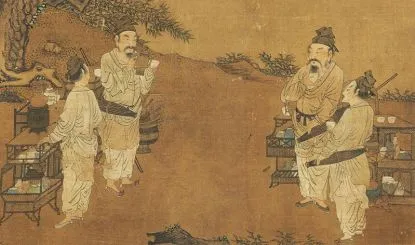




Perspectives on Tea Drinking in the Ming Dynasty
The wars between the Yuan Dynasty and the Song Dynasty did not bring about significant changes to Chinese tea culture. However, the conflict between the Ming Dynasty and the Yuan Dynasty led to a notable disruption of traditional Chinese tea culture when the victorious Ming Dynasty implemented alterations. This pivotal event marked a crucial juncture in the evolution of tea art and culture.

By/ Liu, Han-Chieh, founder of Chun Shui Tea Group
Drinking tea has long been a cherished pastime intricately intertwined with human interaction. As tea culture adapts to shifts in social and economic landscapes, it also mirrors political changes. By the Ming Dynasty, China's tea-drinking tradition had flourished over four millennia, with each region boasting its own rich and nuanced tea culture. This deeply ingrained heritage has been nurtured over centuries and typically remains resilient to change unless influenced by natural disasters or significant upheavals.
The conflicts between the Yuan Dynasty and the Song Dynasty, while tumultuous, did not significantly alter tea culture. However, the clash between the Ming Dynasty and the Yuan Dynasty marked a pivotal moment in the trajectory of traditional Chinese tea culture. Following their victory, the Ming Dynasty temporarily halted the progression of tea culture, leaving a notable impact on its development. This event is truly noteworthy in the annals of tea art and culture.
In the autumn of the twenty-fourth year of the Hongwu reign (1391), the Emperor Zhu, Yuan-Zhang of the Ming Dynasty issued a decree to all tea-producing regions and related departments nationwide. The decree, known as “Abolishing Tea Cakes and Switching to Tribute Leaf Tea”, ordered that from that point on, tea cakes should no longer be produced and presented as tribute to the court. Instead, loose-leaf tea would suffice. This decree was truly groundbreaking at the time. The most delighted group should have been the common people living near the tribute tea-producing areas. Since the Tang Dynasty, tea had been monopolized by the state, and it was forbidden for the common people to openly buy or sell tea. The imperial family lived in luxury, and their tea consumption was of the highest quality. Therefore, the finest and most renowned teas from across the country were selected as tribute items, and county governments were tasked with supervising the production process to ensure the tea was delivered to the court regularly, in specified quantities, and of guaranteed quality. During the Tang Dynasty, the designated area for tribute tea production was situated in Yangxian, which corresponds to modern-day Yixing. In the Song Dynasty, this shifted to Jian'an, now known as Wuyi. During the Song, Hui-Zong era, the highest demand reached 47,000 catties (a unit of weight, approximately 604 kilograms). At that time, the value of one tea cake was equivalent to two taels of gold. The people in the tea-producing regions, in order to fulfill their tribute obligations, abandoned farming and weaving. They rose before dawn on empty stomachs to pick tea leaves. Local government officials exploited them at every turn, and private purchases were extorted. This situation led to the saying, “Moving a thousand catties of tea costs a life, causing countless people to suffer daily”. The production of tea cakes was not just a matter of oppressive governance; it was akin to being devoured by a fierce tiger. As Zhu, Yuan-Zhang came from a humble background, he profoundly understood the hardships faced by the common people. Abolishing the tribute tea system not only rescued the common people from dire circumstances but also represented a rebellion against the culture of extravagance and luxury. Drinking tea should be simpler and more accessible to the common people!
With the evolution of tea processing techniques, the production of drinking utensils underwent a direct transformation. The era of grinding and sieving tea leaves came to an end, replaced by a simpler method where tea leaves could be directly poured into the pot for brewing. As the teapot assumed a central role in the tea-drinking process, its popularity surged.
Jiangxi's Jingdezhen porcelain, renowned since the Tang Dynasty primarily for decorative items like flower vases and water jars, experienced a shift in utility. While greenware porcelain bowls had a moment of popularity, they were not considered essential for tea drinking. After the early Ming period, the tide turned, and teapots and cups for brewing tea became synonymous with Jingdezhen porcelain. Blue-and-white, doucai, famille rose, and colored porcelain teapots became popular nationwide, favored by nobles for indoor tea brewing and literati for outdoor tea tasting. Brewing delicate green tea in Jingdezhen teapots and sipping from Jingdezhen cups became a delightful experience. Brewing delicate green tea in Jingdezhen teapots and drinking from Jingdezhen cups was indeed a pleasure. This period witnessed the democratization of tea drinking. Gone were the elaborate ceremonies and intricate utensils of the past. With tea leaves readily available, individuals could effortlessly brew and enjoy tea anytime, anywhere, in a convenient and leisurely manner. This marked the inception of integrating the art of tea into daily life.
During the Wanli era, someone discovered a colorful clay in Yixing, which was originally a Tang Dynasty tribute tea area. This clay had previously been used to make kitchen utensils and stationery. It was then used to create teapots for brewing tea. These teapots not only possessed an attractive appearance but also imparted a distinct flavor to the brewed tea, surpassing that of porcelain pots. This discovery led to a rapid transition in the trend of tea brewing utensils, with clay pots replacing porcelain pots in popularity. Artisans crafting sand pots often sought to elevate their creations to the status of art treasures. They frequently invited renowned contemporary literati to inscribe poetic verses or calligraphy onto the pots, enhancing their cultural and aesthetic value. Consequently, these purple clay tea pots (Yixing clay teapots) transcended their utilitarian purpose, evolving into cherished artifacts esteemed for their artistic merit and historical significance.
There was a famous Ming Dynasty artisan known for his skill in making teapots. However, a local magistrate, consumed by greed, imprisoned him and demanded that he produce 200 teapots within a month in exchange for his release. Ultimately, the artist chose to commit suicide rather than meet the unreasonable demand.
After the Chongzhen era, the value of Yixing clay teapots soared. A new pot weighing six taels was worth six taels of gold, reaching a level comparable to the tribute tea of the Song Dynasty. This was another significant event in the development of tea culture.
During the Ming Dynasty, literati pursued tea art due to their love for tea. This led to the creation of numerous tea-related literary works, with over forty literati producing such works. Under the influence of literati, Ming people regarded activities such as sweeping, burning incense, reading history, washing inkstones, appreciating paintings, playing the zither, moving couches, cultivating flowers, serving wine, and brewing tea as refined daily activities. Tea drinking became indispensable, with famous tea enthusiasts including Yuan, Hong-Dao, Wu Kuan, Shen Zhou, and Zhang Dai. The Ming people's understanding of tea art, as reflected in literary works such as Xu, Ci-Shu's “Cha Shu”, Tu, Chang-Qing's “Cha Jian”, and Lu Sheng's “Tea Lodge Records”, far surpassed that of the Tang and Song dynasties from a contemporary perspective.
The Ming Dynasty scholar Lu, Shu-Sheng once remarked, “Tea should resonate with one's character; thus, the mastery of tea often circulates among the refined recluses. Those with a backdrop of smoky clouds, misty springs, rugged landscapes, and expansive spirits”. This illustrates how Ming literati elevated the art of tea to a transcendent level. Moreover, tea consumption among Ming monks surpassed that of the Song Dynasty, with monks not only indulging in tea but also engaging in its cultivation and commerce. Many renowned teas of the Ming Dynasty were meticulously roasted by monks.
In the declining years of the Wanli reign, Dutch fleets ventured into China and for the first time, transported tea from Wuyi Mountain in Fujian to Europe. Without a specific name for this tea, they adopted “Wuyi tea” as a generic term for Chinese tea, marking the inaugural recorded export of Asian tea. Today, the pronunciation of the word “tea” in numerous languages worldwide is either derived from Cantonese or Fujianese. This isn't merely imitation; rather, it sets the stage for unfolding drama. Chinese tea exported abroad became a potent tool in the hands of foreigners. To delve deeper, stay tuned for the forthcoming episode.
Expand your listening experience through the “Exploring Tea Culture Podcast”
▾▾▾Listen to the full episode▾▾▾
EP27. [Tea Doctor Shares Everything About Tea] The Culture of Teapot Brewing Began at This Time, and Oolong Tea Flourished - The Yuan and Ming Dynasties Feat. Liu, Han-Chieh (Gan Hou), CEO of Chun Shui Tea Group
Apple:https://reurl.cc/0966MM
Spotify:https://reurl.cc/RWOOMD
KKbox:https://reurl.cc/g4QQKb
Google:https://reurl.cc/zlrr0N
Soundon:https://reurl.cc/Xq55o0
MixerBox:https://reurl.cc/bDzyM6







